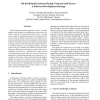Free Online Productivity Tools
i2Speak
i2Symbol
i2OCR
iTex2Img
iWeb2Print
iWeb2Shot
i2Type
iPdf2Split
iPdf2Merge
i2Bopomofo
i2Arabic
i2Style
i2Image
i2PDF
iLatex2Rtf
Sci2ools
ECBS
2002
IEEE
2002
IEEE
On the Relation between Design Contracts and Errors: A Software Development Strategy
When designing a software module or system, a systems engineer must consider and differentiate between how the system responds to external and internal errors. External errors cannot be eliminated and must be tolerated by the system, while the number of internal errors should be minimized and the faults they result in should be detected and removed. This paper presents a development strategy based on design contracts and a case study of an industrial project in which the strategy was successfully applied. The goal of the strategy is to minimize the number of internal errors during the development of a software system while accommodating external errors. A distinction is made between weak and strong contracts. These two types of contracts are applicable to external and internal errors respectively. According to the strategy, strong contracts should be applied initially to promote the correctness of the system. Before release, the contracts governing external interfaces should be weaken...
Related Content
| Added | 14 Jul 2010 |
| Updated | 14 Jul 2010 |
| Type | Conference |
| Year | 2002 |
| Where | ECBS |
| Authors | Eivind J. Nordby, Martin Blom, Anna Brunstrom |
Comments (0)

